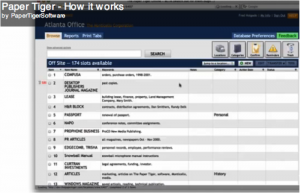The article below is a great start to declutter your home or office and a plan for beginning and maintaining a recycling program for unwanted items.
For the paper files that you need to keep in hard copy format and other items, such as instruction booklets, or CDs, DVDs, Books, home or office inventory and many other physical items, use Paper Tiger Filing System Software for document management to get organized!
For the paper files that you plan to scan for a more paperless (or less paper) environment, use Google Docs as your digital file storage location. Google Docs is the lowest cost digital file storage system available through a Google or Gmail account. And Google Docs would be more convenient than storing your digital files on your hard drive which would take up valuable memory, or keeping up with CDs or Flashdrives.
In addition, Paper Tiger Online Basic and Pro plans have Digital Tiger functionality, which allows customers to connect their Paper Tiger Online account to their Google Docs account. Then they will be able to search from one place to find both their paper/physical items that they’ve indexed into Paper Tiger and their digital files that they’ve uploaded or created into Google Docs format.
Recycling is the most important part of waste management for a home or office to prevent landfills from getting bigger and bigger. Reducing the collective carbon footprint is possible if each individual participates. Offices tend to be impersonal places where employees may not think about what they throw away. Recycling needs to be as easy as leaves to a tree, so that everyone will do it. Here are 10 tips for encouraging employees to recycle waste in an office.
A well organised office will lend itself to a program of recycling. With knowledge and encouragement, employees will soon become accustomed to recycling; and not recycling will become unacceptable. Inform the entire office of the plan. Let the recycling team give tours of the new waste bins and how to use them. Employees need not feel forced into recycling, but they should see for themselves the benefit and want to participate.
About the Author:
John Brook writes reviews of stationery online as well as other business supplies and equipment at the Office Kitten.
Do you hate your alarm clock in the morning? There are a lot of reasons that you might dread going to work, but one of the reasons might be because your desk is overflowing with paperwork. If so, then you need to know the secret to happy filing so your day isn’t so dreadful.
People spend a lot of time at work. In most jobs, there’s some form of filing system and very often that’s what makes the difference between happy and unhappy staff. It’s also a major factor in the overall success of the business when you and your staff can find what is needed, when it’s needed, instead of wasting a lot of time searching through stacks.
Paper is a challenge that everyone faces at work and people constantly seek better alternatives so they can be more efficient with their time. Regardless of the size of your company, there are only five different choices when it comes to dealing with paperwork.

This one is a favorite for many overworked staff members who toss everything they can into the trash. We suggest recycling or shredding as appropriate.
Unfortunately, you simply can’t get away with throwing out everything because so much of this paper contains valuable information and is needed, either now or in the future. This means that you must find another way to file these papers.

This is a great option if you have very little paper to deal with everyday, but when stacks of paper start to appear on your desk. Then more stacks appear on the floor, chairs, shelves and any other flat surface you can use, you have a surmountable problem.
If you have your own office, then it will inevitably become very cramped. If you decide to use this rather disorganized system, you’ll waste countless hours searching through the stacks to find specific files or documents that you need to work on. Experts estimate that 150 hours are wasted each year searching for lost items. There must be a better way.

This type of document management system has been used for a long time as it doesn’t require the use of computers. A filing cabinet or set of drop files is the popular way to store files. However there are problems with this type filing system.
Different people may use varying titles and so file duplication can occur. As your company grows, so does the number of filing cabinets or shelves. Then it becomes increasingly difficult to file new material and locate previously filed documents. If a drawer gets too full, everything needs to be moved so that the alphabetical system remains in order. This can be a very tedious task. Lots of time and money get wasted on such an unproductive part of people’s jobs.

Scanning can be a great way to reduce the amount of paper you use. The office doesn’t need as much storage for files because your filing can be more streamlined. This is a great method of filing IF you’re prepared to tolerate the poor quality of some documents and the fact that there are many types of items that can’t be scanned, such as bound documents, contracts that need to be kept in original paper form, etc. Of course, it also takes time to remove staples in a stapled file, and if you miss any, there will be a jam in the scanner to deal with.
Many people keep the originals in case the scanned documents create problems, thus causing double handling to occur and defeating the whole purpose of trying to streamline your filing system. Some have also said that they wind up reprinting more than they would have if they had just left their files in paper form.
In addition, good quality scanning equipment isn’t cheap and can also be expensive to maintain, not to mention storage of scanned documents. Such equipment can break down easily and cause havoc if there isn’t another option to use for your filing.

It’s the 21st century, afterall. Why should you use methods that are cumbersome and costly in terms of time and money? Indexing is the answer!
No longer will you have to waste hours looking for or recreating that lost document. You can simply conduct a search in the software’s database and instantly you know exactly where the searched file is located.
There are many advantages to an indexing system software:
Indexing is the best choice and the secret to a better and more efficient filing system. Try Paper Tiger Filing System Software for Document Management today!
~~~~~~~~~~~~~~~~~~~~~~~~~~~~~~~~~~~~~~~~~~~~~~~~~~~~~~~~~~~~~~~~~~~~~~~~~~~~~~~~~
~~~~~~~~~~~~~~~~~~~~~~~~~~~~~~~~~~~~~~~~~~~~~~~~~~~~~~~~~~~~~~~~~~~~~~~~~~~~~~~~~